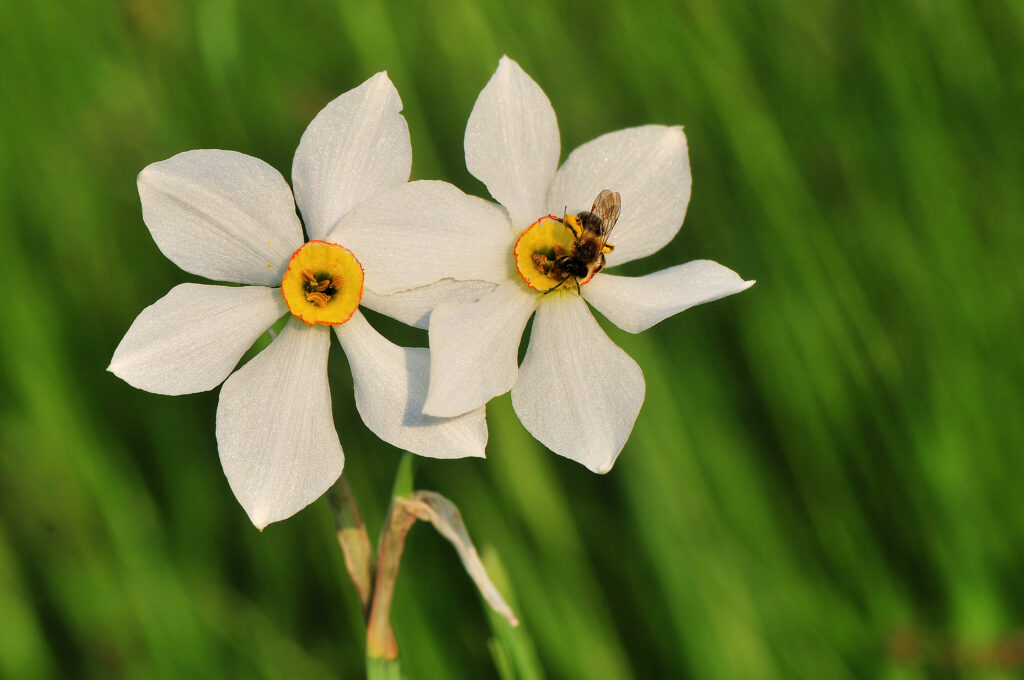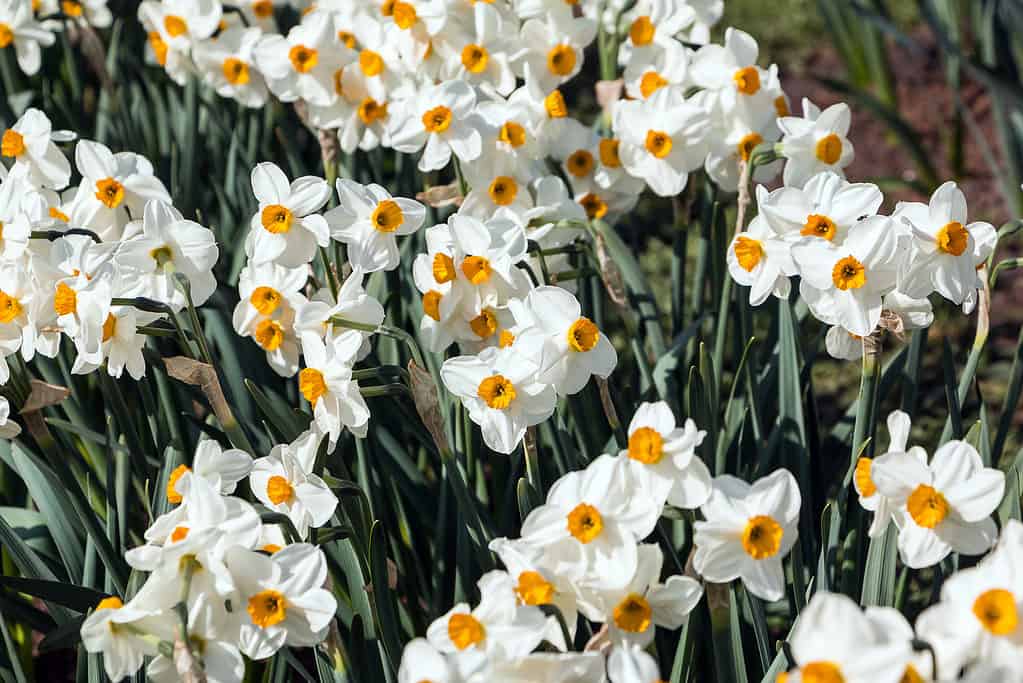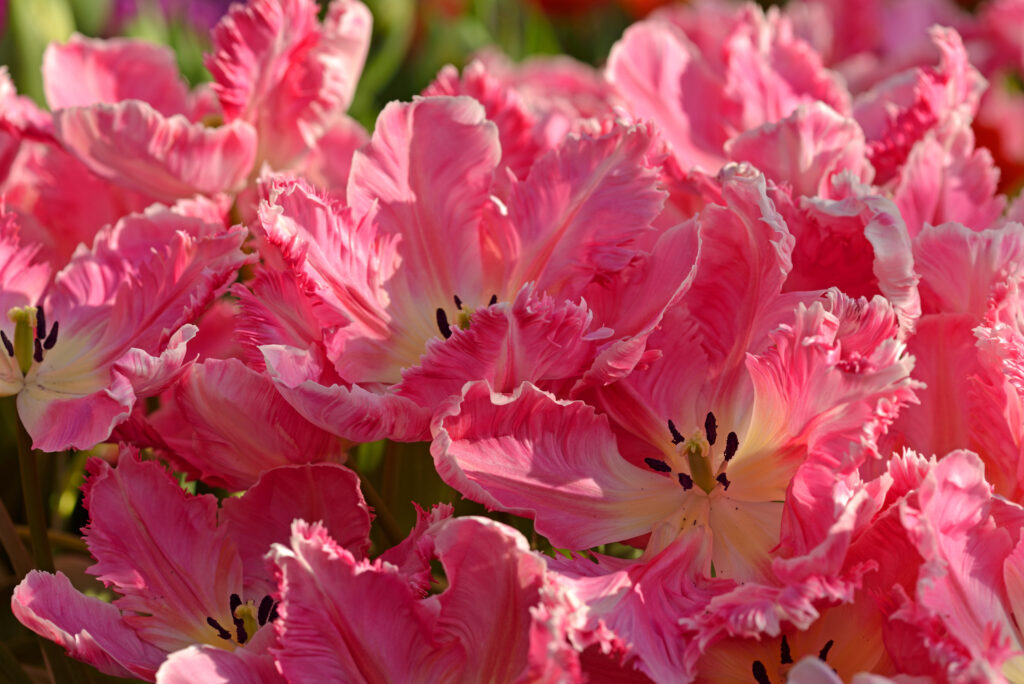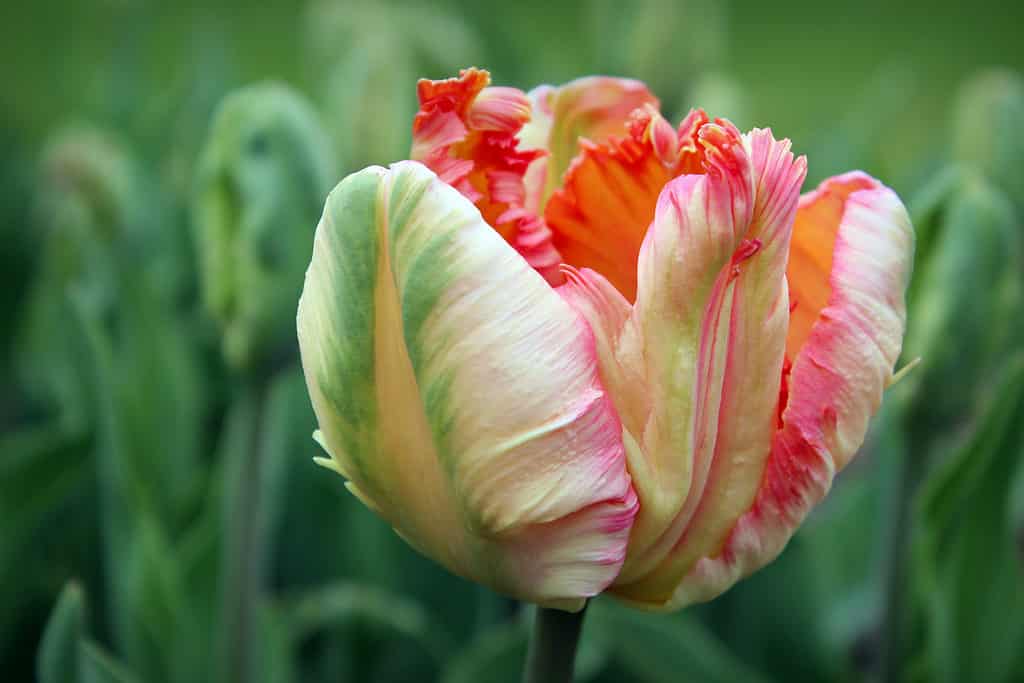There’s something about walking through the garden that has lain dormant all winter to find the first buds popping up and bringing forth color in the wee days of springtime. Both narcissus plants and tulips are among the first flowers to bloom, bringing joy and color with them.

Narcissus Poeticus (daffodil) – The flowers are fantastic pollinator attractors.
©Kristjan Malacic/Shutterstock.com
| Tulips | Narcissus | |
|---|---|---|
| Classification | Tulipa, over 110 species, thousands of hybrids and cultivars | Narcissus, 50+ species |
| Description | Tulips come in a huge range of colors and forms, with practically every shade available, save for true blue colors. The plant has 2 to 3 leaves per stem and may come in solid colors or stripes. | Narcissus have a limited range of colors, including red, white, pink, yellow, cream, and peach. They have various cup shapes, and grow anywhere from 2 to 31 inches tall. |
| Uses | The famous flowers that have inspired festivals the world over, tulips are used both ornamentally and medicinally. They are also edible and frequently used in the culinary world. | Narcissus are early bloomers and provide food for bees and other pollinators, as well as plants, since they die off quickly and provide early food as compost. |
| Origins and growing preferences | Tulips are known to have existed since ancient times, being cultivated in the ancient Ottoman Empire. They became wildly popular in Europe when bulbs were planted in the Netherlands by a botanist. Healthy tulips require full sun, well-draining soil, and cold climates for dormant periods. | Narcissus date back at least as far as ancient Greece, when they played into Greek mythology and the story of the self-loving Narcissus. The plants grow natively in the Mediterranean and have been brought to other regions of the world. They need to be grown in groups, in well-drained soil, in full or half-day sun. |
| Fun facts and intriguing insights | Tulips were once one of the most expensive items on the market, costing something about 10 years’ wages for the average laborer. The flower loves light, even after cut, and will move to face the sun. | Narcissus were brought to Britain by the Romans as an attempt at bringing home remedies with them, not realizing that the plant actually causes skin irritation, not healing it. People often think narcissus and daffodils are synonymous terms for each other, but daffodils are just one plant among the genus containing both plants. |
Key Differences Between Tulip and Narcissus
Two spring flowers signal the coming of the new season. Yet the two plants are very different from each other with distinctive origins, unusual stories, and differing looks and coloring. One is edible, while the other is not.
Tulip vs. Narcissus: Classification

Darwin hybrid tulips can display a variety of colors, including white and pink.
©Printemps PhotoArt/Shutterstock.com
Tulips, known botanically as Tulipa, belong to the lily or Liliaceae family. They are cold-climate plants that come in a range of colors and forms, originating in Asia. They are bulbous plants with large, vibrant flowers, with more than 100 species within the genus. The plants naturally occur in Asia. Many cultivars have been bred for other characteristics, particularly striped forms or distinctive coloring, like black and deep purple shades. “Dutch tulips” typically refer to the cultivated forms of the flowers, based on the historical beginning of the cultivation in the modern world (1500s/1600s) when they became wildly popular in the Netherlands.
Narcissus is a genus of plant that is predominantly a flowering plant in the Amaryllidaceae or amaryllis family. The genus contains popular flowers including daffodils, narcissus, and jonquils. People use the terms interchangeably, not realizing that narcissus is a genus, not merely a synonym for the plant commonly called the daffodil. There are actually 50+ species in the genus.
Tulip vs. Narcissus: Description

‘Geranium’ Tazetta Daffodils is one of the largest species of narcissus.
©Svetlana Mahovskaya/Shutterstock.com
Tulips come in one of the largest ranges of colors in the plant kingdom. They naturally occur in several colors and through hybridization, they now come in practically every color except true blue shades. So, you’ll find red, pink, purple, lilac, violet, orange, white, cream, and yellow shades, as well as striped tulips. The plants grow 2 to 3 blue-green leaves at the bases of their stems, as well, with the flowers containing 3 petals, 3 sepals, and 6 stamens. They are bulb plants.
Narcissus, on the other hand, come in a more limited range of colors: red, white, pink, yellow, cream, or peach. They have various cup shapes, as well, including flat, trumpet-like, or ruffled. The plants may be anywhere from 2 to 31.5 inches tall when they reach full maturity, with dwarf species keeping under 3.5 inches. The plants grow a single, central leafless hollow stem, with several blue-green or green, star-shaped, narrow leaves, with a cluster or solitary flower atop the stem.
Tulip vs. Narcissus: Uses

The ruffled Pink Vision tulip is a particularly intriguing variety of this springtime bloomer.
©Popova Valeriya/Shutterstock.com
Tulips continue to be some of the most sought-after blooms in the world. Festivals celebrate their vibrancy, beauty, and usefulness. The plants are planted in ornamental containers, raised beds, and traditional bed flower gardens. They’re used in pollinator gardens and in cutting gardens. Tulips fill spring bouquets, wedding bouquets, and flower vases. They’re also edible and can replace onions in a salad or cooked dish. Additionally, tulips in skincare products soothe itching, minor wounds, insect bites and stings, and dry skin.
Narcissus are early bloomers, so they are also frequently used in spring ornamental raised beds, container gardens, flower arrangements, and bouquets. They attract pollinators, as well, so they are particularly useful in bee gardens as they provide bees with much-needed food as they begin to come out of their hives and underground homes. People use the leaves, flowers, and bulbs of narcissus in traditional medicine. However, avoid this for safety concerns.
Tulip vs. Narcissus: Origins and Growing Preferences
Springing from bulbs since ancient times, the tulip dates back to the 10th Century when they were grown in Persia. The tulips became the symbol of the Ottoman Empire and remain such today in Iran and Turkey. When tulip bulbs were brought into the western world in the 1560s, the flowers became immensely popular immediately. By the 1630s, they were so popular that a single bulb was one of the most expensive investments a person could make – so much so that the tulip market crashed in the midst of “Tulip mania.” Tulips remain immensely popular the world over, seen as the symbol of spring, a new birth, and a new life.
To grow healthy tulips, plant the bulbs, pointed end up, about 6 to 8 inches deep, about 4 to 6 inches apart. Plant the bulbs in a wire basket or with gravel or kitty litter beneath if you have issues with moles or mice. Make sure the bulbs are in full sun and kept moist but not soggy.
Narcissus plants date back to ancient Greece, at the least, with legendary placement in Greek mythology and the story of Narcissus. The plant natively grows primarily in the Mediterranean region, with a center of diversity in the Iberian Peninsula (Portugal and Spain). Some of the narcissus species range naturally into southern France, the Balkans, and Italy, as well as Palestine. Some varieties are found in east Asia and central Asia, though these are mostly considered to be introductions. The narcissus plant genus isn’t native to North America, but the plants introduced here are widely popular.
To grow healthy narcissus, the plants need to grow in small groups in well-drained soil. The plant prefers full sun, though they can tolerate half-day shade. If you live in a hotter climate, they’ll need protection from the top heat of the sun in summer. Keep the plants well-watered but not soggy.
Tulip vs. Narcissus: Special Features and Fun Facts

Apricot Parrot tulips are a great example of a multi-color flower, complete with the unusual flower color of green in its DNA.
©Joseph Skompski/Shutterstock.com
Tulips and narcissus have many intriguing and funny facts that help set them apart.
- In the 1600s, a single tulip cost approximately 10 years’ worth of wages for the average worker.
- Romans took narcissus flowers to Britain. They believed the family of flowers could heal wounds, so the armies brought their supplies with them. Weirdly, though, the minerals within the sap of the flowers actually irritate skin instead of healing it.
- Tulips are light lovers. So much so that they will bend and turn toward the light. Even if the tulip has been cut and placed in a vase, it will turn towards the light.
- The Narcissus flower genus gets its name from Narcissus in Greek mythology. Self-absorbed in his own reflection, he lost fell into a pool and drowned. The legend says that he came back as the flower.
- The Netherlands remains the largest tulip bulbs producing entity in the world. They produce and export upward of 3 billion tulip bulbs per year.
- Among the narcissus genus is the daffodil. The flower has come to symbolize cheerfulness, thanks to its vibrant colors and cheerful vibe. However, legend has it that if you give a single daffodil and not a bunch, the flower comes to mean misfortune instead.
- Keukenhof in the Netherlands houses the largest tulip garden in the world. It has over 7 million tulips in bloom between April and May each year.
- Narcissus flowers symbolize friendship, cheerfulness, and good fortune. They also represent new beginnings, largely because they are one of the first flowers to bloom in spring. Strongly connected to the holiday of Easter, the flower represents new life.
- Tulips naturally come in a wide range of colors and forms. The solid colors are natural. The striped versions of the flower, however, developed their color through a virus passed to the flowers by aphids, tiny insects that suck the sap out of plants. Since the 1930s when this was discovered, botanists artificially reproduce the virus DNA in plants.
- You should never put narcissus flowers with others into a vase. They release latex from their stems which can impact and shorten the lifespan of the other flowers in the vase. If you only really want a combo bouquet, add some bulb food or soak the narcissus separately for 12 hours before combining them with the other flowers.
The photo featured at the top of this post is ©
Thank you for reading! Have some feedback for us? Contact the AZ Animals editorial team.






